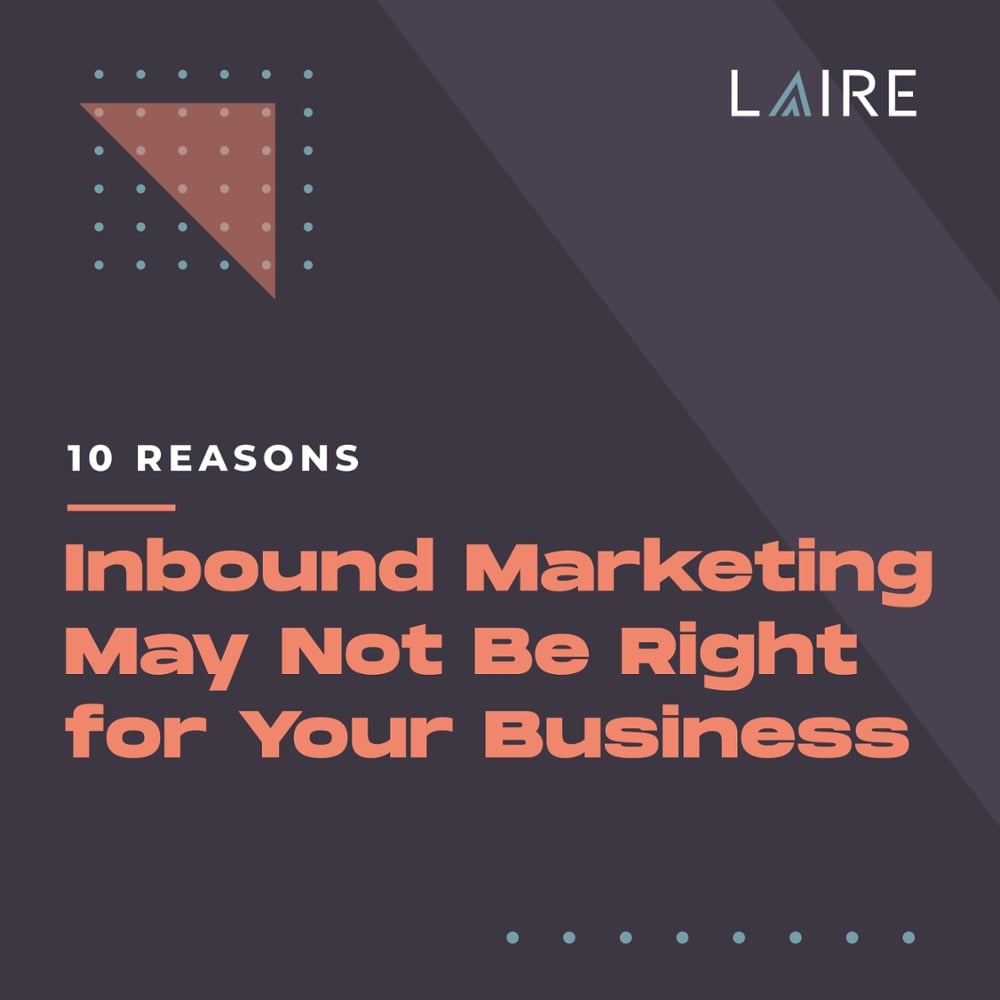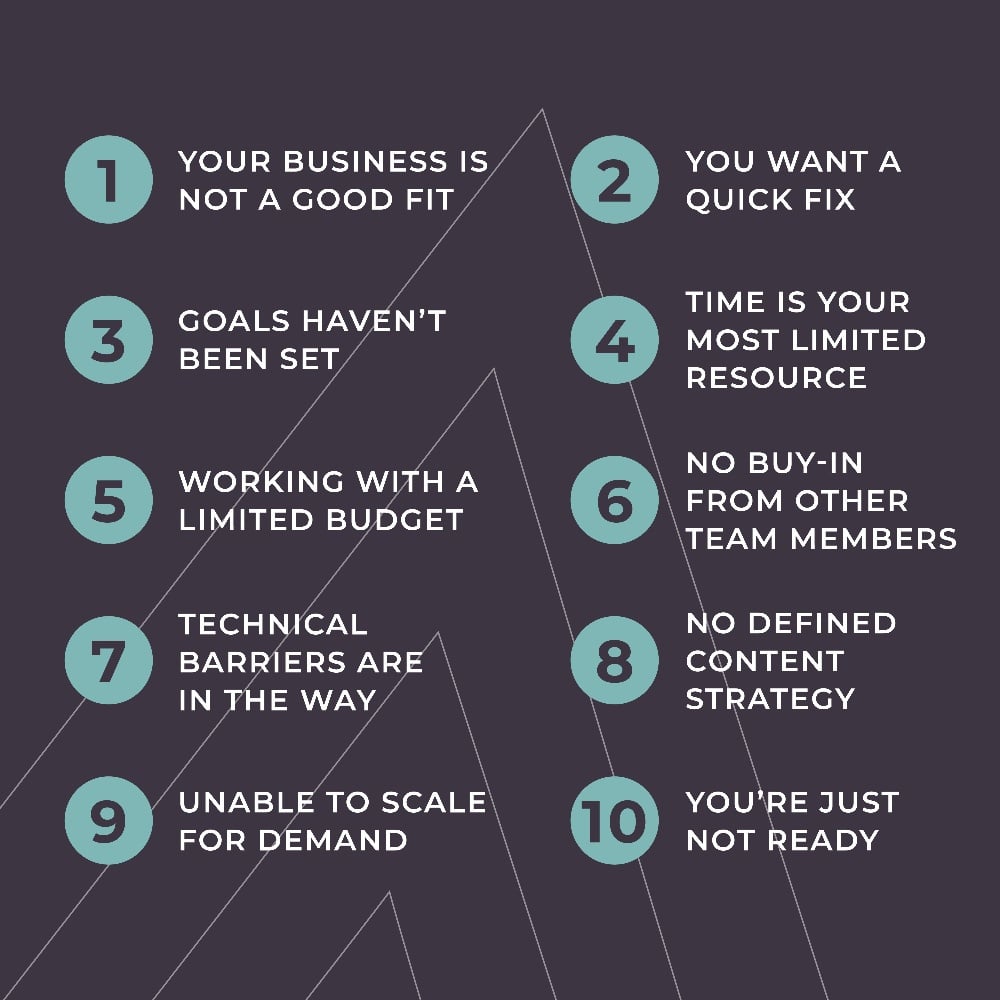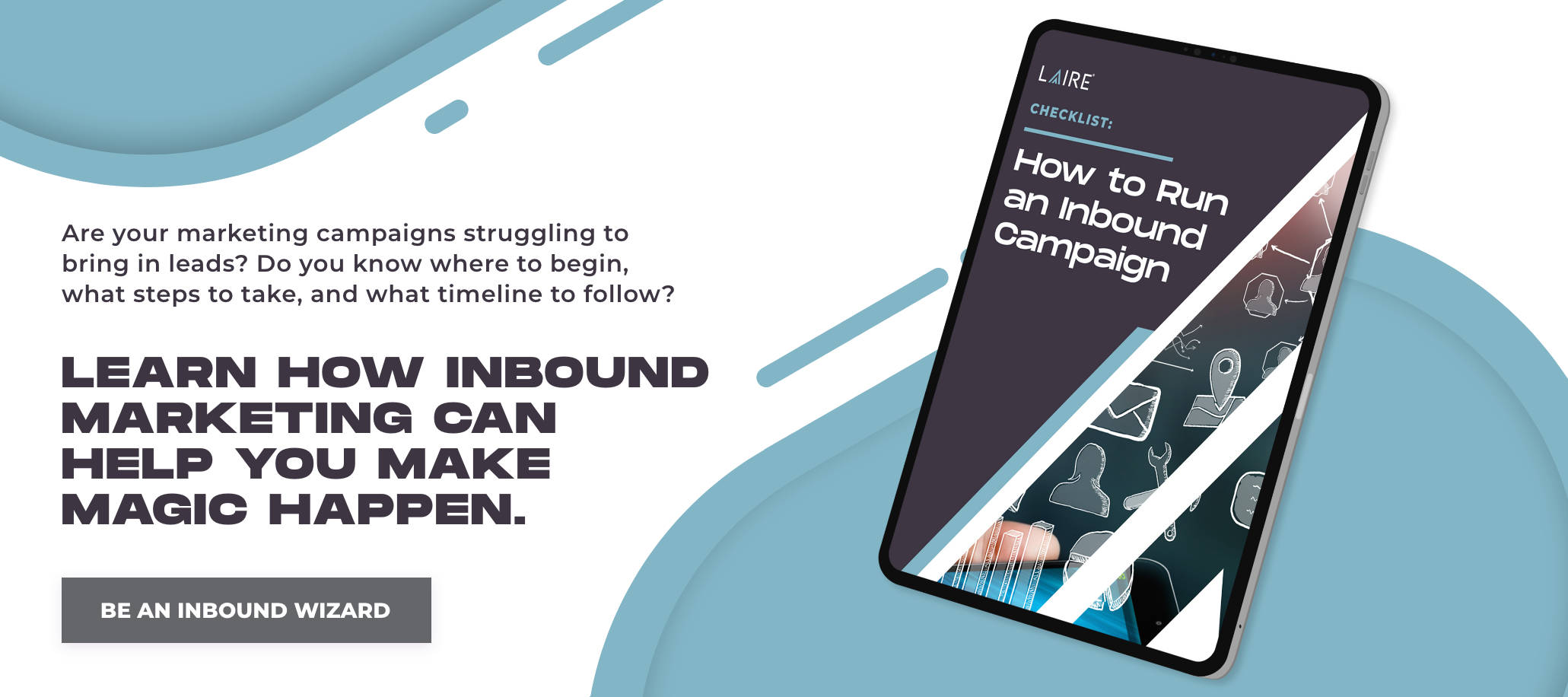So you’re considering inbound marketing to grow your business and reach your revenue goals…
Throughout our many years of developing and executing inbound marketing strategies, we have exposed a series of problems the methodology can present for businesses of all sizes. To save you the years of work to discover and solve these challenges yourself, we want you to learn from our experience.
Below, we demystify inbound marketing by preparing you for 10 challenges that could disrupt your progress. Keep reading to learn more.
1. Your Business Is Not a Good Fit
The inbound methodology is a process of attracting website visitors, converting them to leads, then nurturing those leads into a sale. But it’s not for everyone, and not all types of businesses are a great fit.
Some businesses have transactional relationships with their clients and don’t require lead nurturing because there isn’t a true buying process. If they try to use inbound marketing when they are not a fit, it generally becomes a pretty tough barrier.
2. You Want a Quick Fix
Inbound campaigns touch your website, email marketing, blog, and social media. Each piece of your inbound marketing is the result of a strategic team effort.
Inbound marketing is by no means a “get rich quick” scheme but rather a “get richer over time” plan. It takes a certain amount of time — usually, at least 12 months — and patience from all parties involved to get the most out of an inbound strategy.
Unlike its outbound counterparts, inbound marketing is the long game. You don’t flip it on and off when you need more business. You must commit to creating a plan and implementing it to drive more quality leads consistently and long-term.
3. Goals Haven't Been Set
One of the first questions we ask our potential clients is: What are your goals?
Sure, every good business owner has an idea of where they see their organization in the future. The problem here is that we’re not asking for your aspirations — we’re asking for your SMART (specific, measurable, attainable, relevant, and timely) goals.
Inbound marketing optimizes your success based on realistic metrics you set within your company. SMART goals allow us to match up our rich data against your benchmarks so we know we’re on the right track. Starting the inbound process without a standard (or worse, impractical ideas) can make for an unhappy ending.
If you want to try and implement the inbound methodology, it requires a great deal of research, planning, and strategy. Start by creating a marketing plan, which will be your road map to getting to your goals. Include in that plan the following well-researched items:
- Company goals
- Ideal buyer personas
- Buyer persona pain points or challenges
- Topics and messaging that positions your product or service as a solution to those pain points
- A content distribution plan to attract and help your ideal buyer persona
Often, business owners and executives want to jump right in and skip this crucial phase, but the results can be haphazard and disjointed.
4. Time Is Your Most Limited Resource
In reality, learning inbound marketing software like HubSpot, utilizing it to its full extent, and continuously blogging and creating new premium content offers is too big of a time commitment for some businesses. As soon as a bigger priority enters the scene, inbound efforts can be left on the sideline.
This often results in animosity towards the process as business owners are paying for the software and not getting the results they expected.
This is often where LAIRE comes in, as business owners realize they just don’t have the manpower to manage inbound marketing long-term.
5. You’re Working With a Limited Budget
Many businesses consider retaining an in-house marketing team or director — but this will likely cost you more than inbound marketing software and outsourced services.
Inbound packages come in at varying levels of monetary commitment, but at each price point, you get an entire team working for you. Rather than paying one or multiple in-house team members an individual salary, you can get an entire team in your corner for less.
6. No Buy-In From Other Team Members
We cannot stress this enough. It is vital that all the key stakeholders in your organization fully understand what inbound marketing is, what the financial and time commitment is, and what outcomes to expect.
If any important people in your company do not believe in it, do not understand it, or are unwilling to invest in it, you are setting yourself up for failure.
It is worth the time taken ahead of the process to truly earn that trust from those who matter.
7. Technical Barriers Are Getting in the Way
Inbound marketing utilizing HubSpot software should not present very many technical challenges, as the interface was designed to be very intuitive and easy to use.
But HubSpot also has dedicated staff waiting and ready to jump in and help business owners and marketers who need guidance. In addition, they have an endless supply of resources, training videos, and certifications to earn through the HubSpot Academy.
At LAIRE when we learn of technical barriers causing businesses problems with their inbound marketing, it is often the same roadblocks: time and willingness. Often, those who try to tackle the large undertaking of inbound marketing themselves, just don’t have the time to commit to learning, or they have other things they would rather be doing.
Entrepreneurs are passionate people who want to work on big ideas and not get stuck on the tactical side of the business. If this sounds familiar, we advise you to be truthful about your willingness and abilities and find a HubSpot partner agency to handle inbound marketing for you.
8. There’s No Defined Content Strategy
Content can become a challenge when businesses do not take the time to develop quality content that was built with their buyer personas in mind.
Creating content for the sake of creating content will get you nowhere. When you are blogging and developing premium offers, you have to focus on your buyer personas, their pain points, and the solutions you can offer.
If you provide relevant, useful, and trustworthy answers to your buyer personas' biggest questions, you’re more likely to attract the right traffic to your website to convert into a lead and later close as a client.
9. You’re Unable to Scale for Demand
Often, we see companies that aren’t able to handle a heavy influx of leads. Realistically, those who are considering inbound marketing should have a plan for future growth. Continual expansion is one of the most common goals for startups and young companies, but you need to be in a position where that can become a quick reality.
Our goal, and the methodology behind inbound marketing, is to both increase your leads and better qualify them as they go through your marketing funnel and into your sales pipeline. A number of businesses just aren’t ready for an increased workload.
We tell entrepreneurs to take a critical look at their goals and plans and determine if they’re ready to scale for demand. Paying for marketing that generates new business you’re not equipped for is not what inbound marketing is about.
10. You’re Just Not Ready
If you’re thinking of outsourcing your inbound marketing efforts, it’s important to remember that having another set of eyes filter through your company’s processes and tactics can be a tough pill to swallow. The metaphorical microscope that’s held over your marketing can uncover mishaps and errors from previous efforts.
Throughout the past year, we’ve seen professionals who simply do not want to give up their tagline, website layout, or direct mailers. Committing to inbound marketing means that you need to determine what truly represents the remarkable aspects of your business. If you’re unwilling to give up old-school tactics and take calculated risks, then inbound may not be right for you.
Inbound Takes Time and Effort — We Can Help
While inbound marketing can be a large investment of time and money, it’s a long-term game with benefits that far outlive the initial investment. When done right, the work you do and the content you create today can bring you qualified leads in one, five, or even ten years’ time.
It takes a certain team, perspective, and commitment to be successful with inbound marketing. If you’re considering inbound marketing for your business, we urge you to take the time to get buy-in, learn the system, and commit to the long-term efforts required to do it right.
To help you get started, download our Inbound Marketing Checklist and start building your own custom campaign that connects with your ideal buyers.


